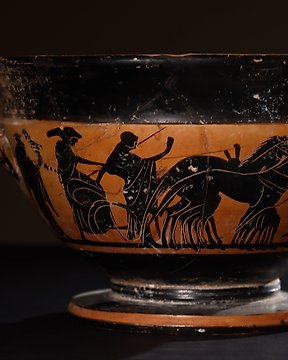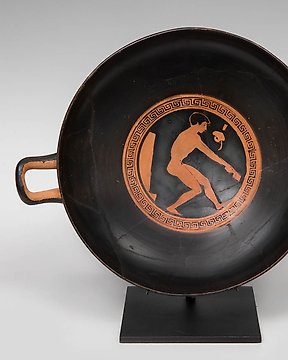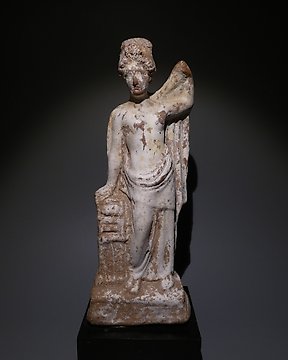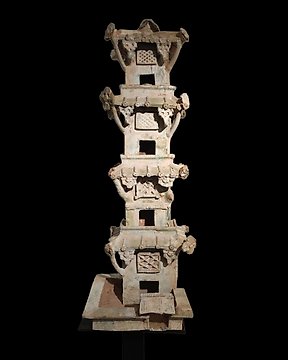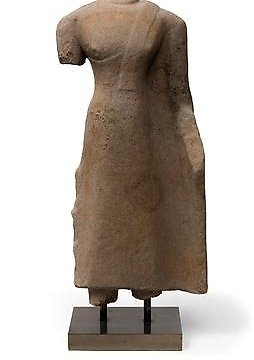All OK and with very fast shipping.
Vertaling bekijkenOud-Grieks Keramiek Skyphos met strijdwagenscènes. 6e eeuw voor Christus. 27,3 cm L.
Nr. 84871993



Skyphos with chariot scenes.
Ancient Greek, Attica, 6th century BC.
Ceramic.
27.3 cm Large and 11.5 cm heigth.
Condition: Recomposed from all original fragments.
Provenance: Private collection, Mr. S, Ghent, Belgium. 1970 - 1980.
Description:
A skyphos is a deep wine cup with two handles and a low, wide base, or no base. The handles are small and horizontal, projecting from the edge, or loop-shaped that sit on the edge or protrude from the base. There is a type of this glass called glaux (owl) that has one horizontal handle and the other vertical. The oldest examples are from the Geometric period. They were also made with precious metals.
The black figure technique was based on the use of a transparent varnish that, when fired, acquired an intense and shiny black hue. Therefore, the motifs were invisible before firing, due to which the painters had to work completely from memory, without being able to see their previous work. Once the piece was fired, the areas not covered by the varnish remained with the reddish tone of the clay, while the glazed, “painted” areas took on a dense and shiny black color. The black figure technique was introduced in Corinth around 700 BC, being adopted by Attic artists in the orientalizing period (725 – 625 BC). The great series of black-figure ceramics then began, which had its main center in Athens and which lasted until the beginning of the 5th century BC.
Attica, a region in southern Greece that has Athens as its capital, was therefore the birthplace of the red figure technique at the end of the 6th century. It remained the main center of production for this type of pottery, although the style was also adopted in other parts of Greece, Magna Graecia (Italy) and Etruria. The previous style, that of black figures, had appeared in Corinth in the 7th century BC. At first, Athens copied the Corinthian style, but it soon achieved such quality that it rivaled, first, and then surpassed Corinth itself. Attic artists, still in the black-figure period, brought the style to the peak of its development in the mid-6th century BC. By the following century, Attica completely dominated the market, with predominantly red-figure ceramics that were exported throughout Greece and even to Italy, where its own schools were developed, strongly influenced by the Attic style.
Notes:
- The piece includes authenticity certificate.
- The piece includes Spanish Export License (Passport for European Union) - If the piece is destined outside the European Union a substitution of the export permit should be requested, can take between 1-2 weeks maximum.
- The seller guarantees that he acquired this piece according to all national and international laws related to the ownership of cultural property. Provenance statement seen by Catawiki.
#ancientcivilisations
De verkoper stelt zich voor
Skyphos with chariot scenes.
Ancient Greek, Attica, 6th century BC.
Ceramic.
27.3 cm Large and 11.5 cm heigth.
Condition: Recomposed from all original fragments.
Provenance: Private collection, Mr. S, Ghent, Belgium. 1970 - 1980.
Description:
A skyphos is a deep wine cup with two handles and a low, wide base, or no base. The handles are small and horizontal, projecting from the edge, or loop-shaped that sit on the edge or protrude from the base. There is a type of this glass called glaux (owl) that has one horizontal handle and the other vertical. The oldest examples are from the Geometric period. They were also made with precious metals.
The black figure technique was based on the use of a transparent varnish that, when fired, acquired an intense and shiny black hue. Therefore, the motifs were invisible before firing, due to which the painters had to work completely from memory, without being able to see their previous work. Once the piece was fired, the areas not covered by the varnish remained with the reddish tone of the clay, while the glazed, “painted” areas took on a dense and shiny black color. The black figure technique was introduced in Corinth around 700 BC, being adopted by Attic artists in the orientalizing period (725 – 625 BC). The great series of black-figure ceramics then began, which had its main center in Athens and which lasted until the beginning of the 5th century BC.
Attica, a region in southern Greece that has Athens as its capital, was therefore the birthplace of the red figure technique at the end of the 6th century. It remained the main center of production for this type of pottery, although the style was also adopted in other parts of Greece, Magna Graecia (Italy) and Etruria. The previous style, that of black figures, had appeared in Corinth in the 7th century BC. At first, Athens copied the Corinthian style, but it soon achieved such quality that it rivaled, first, and then surpassed Corinth itself. Attic artists, still in the black-figure period, brought the style to the peak of its development in the mid-6th century BC. By the following century, Attica completely dominated the market, with predominantly red-figure ceramics that were exported throughout Greece and even to Italy, where its own schools were developed, strongly influenced by the Attic style.
Notes:
- The piece includes authenticity certificate.
- The piece includes Spanish Export License (Passport for European Union) - If the piece is destined outside the European Union a substitution of the export permit should be requested, can take between 1-2 weeks maximum.
- The seller guarantees that he acquired this piece according to all national and international laws related to the ownership of cultural property. Provenance statement seen by Catawiki.
#ancientcivilisations
De verkoper stelt zich voor
- 745
- 6
- 0
Prachtig schilderij. Zo blij mee. Zeer nette verkoper en zeer snelle levering.
Vertaling bekijkenperfect ! very fast and high quality delivery !
Vertaling bekijkenAll well! Thanks.
Vertaling bekijkenVendeur très professionnel, top +++×
Vertaling bekijkenPhotos trop contrastées pour bien percevoir les défauts, mais ces défauts étaient visibles pour autant. Le "Bon état" est trompeur. Sinon, envoi rapide et correctement emballé. Frais de port exagérés.
Vertaling bekijkenGreat communication, delivery and product. Came with a well made certificate of authenticity and good packaging. Overall very happy with the purchase! Delivery is a bit expensive, but I recommend it
Vertaling bekijkenMagnifique témoin du passé, envoyé avec tous les justificatifs, impeccable. Encore une fois très satisfait, un grand merci
Vertaling bekijkenThank you for the Special offer and the fast shipping of this excellent piece of art!
Vertaling bekijkenvery good description of the object, very good price for this rare item,. Fast sending (has been at my place 2 days after buying!). Definitely would buy again.
Vertaling bekijkenSehr schön
Vertaling bekijkenAs described, perfect logistic
Vertaling bekijkengreat seller, everything came as should with certificate of authenticity
Vertaling bekijkenExceptionally well packaged, description aligned with positing received
Vertaling bekijkenReally precious, but without sound...
Vertaling bekijkenPainting well packed and rapidly sent!
Vertaling bekijkensempre grande rapidità e professionalità
Vertaling bekijkenparfait bien reçu, merci
Vertaling bekijkenVery satisfied with the small Greek Lekythos. As always (we have already bought several items from Bagot), the object was wrapped and sent immediately and with the greatest care.
Vertaling bekijkenPerfect, excellent condition, good packaging, the parcel arrived without any problems… all is perfect as usual. Thank you very much and wait for an other nice piece like this one. Gilles.
Vertaling bekijken+++ Top vendeur professionnel comme d'habitude
Vertaling bekijkenEmbora o custo de transporte esteja acima da média foi, realmente, muito bem executado e em embalagem cuidada. Expeditos e profissionais. Recomendo
Vertaling bekijkenSnel en correct en goed verpakt verzonden
Vertaling bekijkenoggetto bellissimo, fedele alla descrizione, venditore affidabile
Vertaling bekijkenVery nice piece and fast delivery
Vertaling bekijken- 745
- 6
- 0
All OK and with very fast shipping.
Vertaling bekijkenDisclaimer
De verkoper garandeert dat het object legaal is verkregen en kan dit bewijzen. Catawiki heeft de verkoper geïnformeerd dat hij/zij documentatie moet overleggen die vereist is volgens de wetten in hun land van verblijf. De verkoper garandeert dat hij/zij toestemming heeft om het object te verkopen/exporteren. De verkoper zal alle over het object bekende herkomstgegevens aan de koper verstrekken. De verkoper zorgt ervoor dat eventueel benodigde vergunningen zijn/zullen worden geregeld. De verkoper zal de koper onmiddellijk informeren over eventuele vertragingen bij het verkrijgen van dergelijke vergunningen.
De verkoper garandeert dat het object legaal is verkregen en kan dit bewijzen. Catawiki heeft de verkoper geïnformeerd dat hij/zij documentatie moet overleggen die vereist is volgens de wetten in hun land van verblijf. De verkoper garandeert dat hij/zij toestemming heeft om het object te verkopen/exporteren. De verkoper zal alle over het object bekende herkomstgegevens aan de koper verstrekken. De verkoper zorgt ervoor dat eventueel benodigde vergunningen zijn/zullen worden geregeld. De verkoper zal de koper onmiddellijk informeren over eventuele vertragingen bij het verkrijgen van dergelijke vergunningen.
